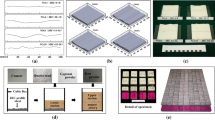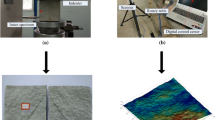Abstract
A new constitutive model to describe the shear behavior of rock joints under constant normal stiffness (CNS) and constant normal load (CNL) conditions is proposed. The model was developed using an empirical approach based on the results of a total of 362 direct shear tests on tensile fractured rock joints and replicas of tensile joints and on a new quantitative roughness parameter. This parameter, the active roughness coefficient C r, is derived from the features of the effective roughness mobilized at the contact areas during shearing. The model involves a shear strength criterion and the relations between stresses and displacements in the normal and shear directions, where the effects of the boundary conditions and joint properties are considered by the shape indices C d and C f. The model can be used to predict the shear behavior under CNS as well as CNL conditions. The shear behavior obtained from the experimental results is generally in good agreement with that estimated by the proposed model, and the effects of joint roughness, initial normal stress, and normal stiffness are reasonably reflected in the model.



























Similar content being viewed by others
References
Awrejcewicz J, Olejnik P (2005) Analysis of dynamic systems with various friction laws. Appl Mech Rev 58:389–411
Bandis SC, Lumsden AC, Barton NR (1981) Experimental studies of scale effects on the shear behaviour of rock joints. Int J Rock Mech Min Sci Geomech Abstr 18:1–21
Bandis SC, Lumsden AC, Barton NR (1983) Fundamentals of rock joint deformation. Int J Rock Mech Min Sci Geomech Abstr 20:249–268
Barton N (1973) Review of a new shear-strength criterion for rock joints. Eng Geol 7:287–332
Barton N, Bandis S (1990) Review of predictive capabilities of JRC-JCS model in engineering practice. In: Barton N, Stephansson O (eds) Rock joints. Balkema, Rotterdam, pp 603–610
Barton N, Choubey V (1977) The shear strength of rock joints in theory and practice. Rock Mech Rock Eng 10:1–54
Barton N, Bandis S, Bakhtar K (1985) Strength, deformation and conductivity coupling of rock joints. Int J Rock Mech Min Sci Geomech Abstr 22:121–140
Brown ET (ed) (1981) ISRM suggested methods: rock characterization testing and monitoring. Pergamon, Oxford
Byerlee JD (1970) The mechanics of stick-slip. Tectonophysics 9:475–486
Crotty JM, Wardle LJ (1985) Boundary integral analysis of piecewise homogeneous media with structural discontinuities. Int J Rock Mech Min Sci Geomech Abstr 22:419–427
Goodman RE (1974) The mechanical properties of joints. In: Proceedings of the 3rd congress of international society of rock mechanics, Denver, pp 127–140
Goodman RE (1976) Methods of geological engineering in discontinuous rocks. West, New York
Grasselli G, Egger P (2003) Constitutive law for the shear strength of rock joints based on three-dimensional surface parameters. Int J Rock Mech Min Sci 40:25–40
Haberfield CM, Johnston IW (1994) A mechanistically-based model for rough rock joint. Int J Rock Mech Min Sci Geomech Abstr 31:279–292
Hintze JL (2007) NCSS 2007: Statistical analysis and graphics. User’s Guide, Number Cruncher Statistical Systems, Kaysville, Utah
Huang SL, Oelfke SM, Speck RC (1992) Applicability of fractal characterization and modeling to rock joint profiles. Int J Rock Mech Min Sci Geomech Abstr 29:89–98
Indraratna B, Haque A (1997) Experimental study of shear behavior of rock joint under constant normal stiffness conditions. Int J Rock Mech Min Sci 34(3-4):141.e1–141.e14
Indraratna B, Haque A, Aziz N (1998) Laboratory modelling of shear behaviour of soft joints under constant normal stiffness conditions. Geotech Geol Eng 16:17–44
Jiang Y, Xiao J, Tanabashi Y, Mizokami T (2004) Development of an automated servo-controlled direct shear apparatus applying a constant normal stiffness condition. Int J Rock Mech Min Sci 41:275–286
Jiang Y, Li B, Tanabashi Y (2006) Estimating the relation between surface roughness and mechanical properties of rock joints. Int J Rock Mech Min Sci 43:837–846
Johnston IW, Lam TSK, Williams AF (1987) Constant normal stiffness direct shear testing for socketed pile design in weak rock. Géotechnique 37:83–89
Kodikara JK, Johnston IW (1994) Shear behaviour of irregular triangular rock-concrete joints. Int J Rock Mech Min Sci Geomech Abstr 31:313–322
Kulatilake PHSW, Shou G, Huang TH, Morgan RM (1995) New peak shear strength criteria for anisotropic rock joints. Int J Rock Mech Min Sci Geomech Abstr 32:673–697
Ladany B, Archambault G (1970) Simulation of shear behavior of a jointed rock mass. In: Proceedings of the 11th US symposium on rock mechanics, New York, pp 105–125
Lee HS, Park YJ, Cho TF, You KH (2001) Influence of asperity degradation on the mechanical behavior of rough rock joints under cyclic shear loading. Int J Rock Mech Min Sci 38:967–980
Maerz NH, Franklin JA, Bennett CP (1990) Joint roughness measurement using shadow profilometry. Int J Rock Mech Min Sci Geomech Abstr 27:329–343
Ohnishi Y, Dharmaratne PGR (1990) Shear behaviour of physical models of rock joints under constant normal stiffness condition. In: Barton N, Stephansson O (eds) Rock joints. Balkema, Rotterdam, pp 413–422
Olsson R, Barton N (2001) An improved model for hydromechanical coupling during shearing of rock joints. Int J Rock Mech Min Sci 38:317–329
Park JW, Song JJ (2013) Numerical method for determining contact areas of a rock joint under normal and shear loads. Int J Rock Mech Min Sci 58:8–22
Patton FD (1966) Multiple modes of shear failure in rock. In: Proceedings of the 1st congress of international society of rock mechanics, vol 1. Lisbon, pp 509–513
Plesha ME (1987) Constitutive models for rock discontinuities with dilatancy and surface degradation. Int J Numer Anal Meth Geomech 11:345–362
Rim HR, Choi HJ, Son BK, Lee CI, Song JJ (2005) Experimental study for shear behaviour of pseudo rock joint under constant normal stiffness condition. In: Proceedings of the 31st ITA-AITES world tunnel congress on underground space use, Istanbul, pp 175–181
Saeb S, Amadei B (1990) Modelling joint response under constant or variable normal stiffness boundary conditions. Int J Rock Mech Min Sci Geomech Abstr 27:213–217
Schneider H (1976) The friction and deformation behaviour of rock joints. Rock Mech Rock Eng 8:169–184
Scholz CH, Engelder JT (1976) The role of asperity indentation and ploughing in rock friction-I: asperity creep and stick-slip. Int J Rock Mech Min Sci Geomech Abstr 13:149–154
Seidel JP, Haberfield CM (2002a) Laboratory testing of concrete-rock joints in constant normal stiffness direct shear. Geotech Test J 25:391–404
Seidel JP, Haberfield CM (2002b) A theoretical model for rock joints subjected to constant normal stiffness direct shear. Int J Rock Mech Min Sci 39:539–553
Skinas CA, Bandis SC, Demiris CA (1990) Experimental investigations and modelling of rock joint behavior under constant stiffness. In: Barton N, Stephansson O (eds) Rock joints. Balkema, Rotterdam, pp 301–308
Son BK, Lee CI, Park YJ, Lee YK (2006) Effect of boundary conditions on shear behaviour of rock joints around tunnel. Tunn Undergr Sp Tech 21:347–348
Tse R, Cruden DM (1979) Estimating joint roughness coefficients. Int J Rock Mech Min Sci Geomech Abstr 16:303–307
Van Sint Jan ML (1990) Shear tests of model rock joints under stiff normal loading. In: Barton N, Stephansson O (eds) Rock joints. Balkema, Rotterdam, pp 323–327
Xie H, Sun H, Ju Y, Feng Z (2001) Study on generation of rock fracture surfaces by using fractal interpolation. Int J Solids Struct 38:5765–5787
Yang ZY, Chiang DY (2000) An experimental study on the progressive shear behavior of rock joints with tooth-shaped asperities. Int J Rock Mech Min Sci 37:1247–1259
Yeo IW, de Freitas MH, Zimmerman RW (1998) Effect of shear displacement on the aperture and permeability of a rock fracture. Int J Rock Mech Min Sci 35:1051–1070
Yu X, Vayssade B (1991) Joint profiles and their roughness parameters. Int J Rock Mech Min Sci Geomech Abstr 28:333–336
Acknowledgments
This research was supported by a National Research Foundation of Korea (NRF) grant funded by the Ministry of Education, Science, and Technology of Korea (No. 2012-0005326), and supported by a Basic Research Project of the Korea Institute of Geoscience and Mineral Resources (KIGAM, GP2012-001) funded by the Ministry of Knowledge and Economy of Korea. We appreciate anonymous reviewers for their valuable comments and suggestions to improve this manuscript.
Author information
Authors and Affiliations
Corresponding author
Rights and permissions
About this article
Cite this article
Park, JW., Lee, YK., Song, JJ. et al. A Constitutive Model for Shear Behavior of Rock Joints Based on Three-Dimensional Quantification of Joint Roughness. Rock Mech Rock Eng 46, 1513–1537 (2013). https://doi.org/10.1007/s00603-012-0365-4
Received:
Accepted:
Published:
Issue Date:
DOI: https://doi.org/10.1007/s00603-012-0365-4




